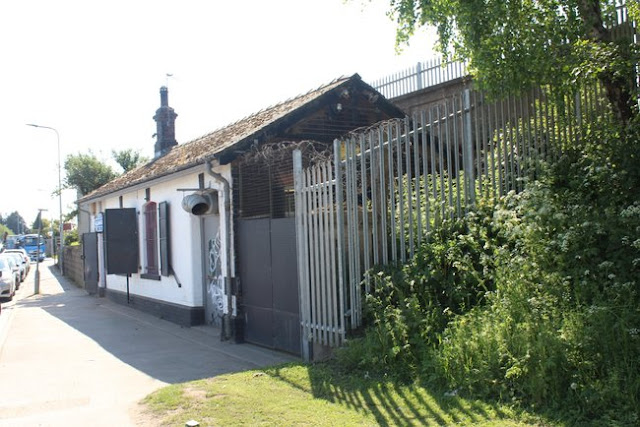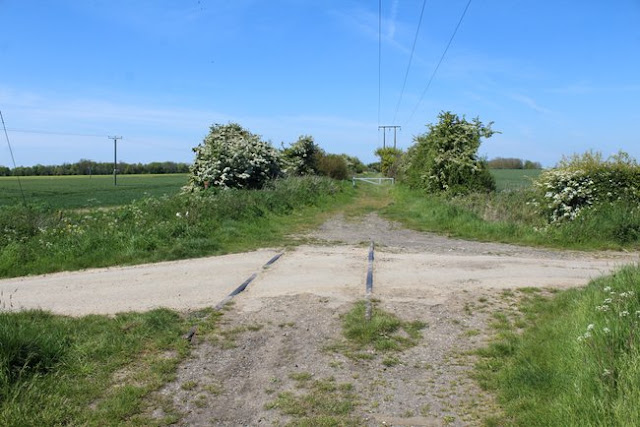Above - Old postcard of Withernsea station (Wikipedia)
Starting Point - Duesbery Street, Hull. Finish Point - Former Patrington Station. Distance 16.3 Miles
The line between Victoria Station, situated adjacent to Hull's Victoria Dock to the east of the city and the coastal town of Withernsea was opened in 1853. From 1864 trains from Withernsea continued in to Hull's main Paragon station via the Victoria Dock Branch and the station at Victoria Dock was closed to passengers, becoming Drypool Goods Station.
The line was closed as part of the Beeching cuts, closing to passengers in October 1964 and to freight in May 1965 apart from sections nearer Hull that clung on a little longer.
Much of the railway formation survives as far as Patrington, as a cycle route to Keyingham and continuing a bit further as a footpath to Ottringham (though the cycle route has gradually been extended eastwards so may continue further given time). Beyond Patrington the route has been ploughed in to adjoining fields aside from a short stretch through a park on the aproach to Withernsea. The former station site at Withernsea survived in to the early 2000s as part of Withernsea Market, however the market has been downsized and the station demolished with the site now occupied by the modern Withernsea police station. Excuse any puns but surely a criminal act of historic vandalism. Just a length of platform edge at the back of the car park survives of the station.
I covered the Victoria Branch as far as Wilmington on my ride of the Hornsea line which diverged at that point so for any that have read that account apologies for a bit of repetativeness as I go over that stretch again since I started this route at the same point, the Victoria Dock branch being a far better traffic free route across Hull than heading through the town and A63. Like my Hornsea journey I did this one out and back on my bike, though it could potentially be done as a walk by getting the bus back.
The Victoria Branch joined the lines in to Hull Paragon at West Parade Juction, where a stub of the line survives to the Botanic Gardens depot in which Northern's trains for services centred on Hull are maintained. The first passenger station was provided at Botanic Gardens was on the north side of a level crossing on Spring Bank, now occupied by the Old Zoological pub. Just a section of retaining wall at the back of the Jet petrol station survives.
Below - Photo from Pinterest of a Withernsea train calling at Botanic Gardens.
Just beyond Botanic Gardens station site the railway trackbed can be joined at the end of Duesbery Road and soon brings us to the next station at Stepney where the line crossed the busy Beverley Road on another of its notorious level crossings.
Below - Stepney station with an installation of waiting passengers on the former Withernsea and Hornsea bound platform.
Not far from Stepney we reach Wilmington. The large goods shed that served the industrialised areas around the River Hull survives as a listed building but still in industrial use. The original Sculcoates station was situated at this point, though replaced in 1912 by Wilmington station closer to the junction on the other side of the river.
The swing bridge across the River Hull also carried a footpath and as a result was retained and manned for many years after the railway closed. The path has been moved from the side of the bridge on to the bridge deck that carried the railway lines. There is seldom any need to open the bridge to river traffic these days.
Below - The small station building of the later Wilmington station, behind the station can be seen the former entrance to the subway that gave access to a wooden island platform. The station site, and a lot of the surrounding area has been redeveloped for industrial use. As a result of this there is a bit of a detour at this point to pick up the railway trackbed at the back of Rosmead Playing Field where it passes under Southcoates Lane flyover alongside the surviving line in to Hull's docks. Unfortunately missing the site of Southcoates station, though nothing remains of this.
The former Marfleet station building survives in industrial use on the corner of Marfleet Avenue and Marfleet Lane, a tall metal fence now shield it from view from the railway trackbed. The platform edges can still be seen. The line survived a bit longer up to here for freight use until 1972 with several important industrial sites close by to the north of Hedon Road as a result of the nearby docklands. A couple of big names to have been based in the area included crane make Priestman and paint maker Humbrol. Now a vast site that we follow for a while on the right hand side is that of Willerby Caravans who make static caravans at the site.
The next station was Hedon Racecourse built to serve a nearby racecourse it was only used on race days and closed in 1909 when racing finished. The site was later used for speedway meetings resulting in it being briefly used again during 1948 under the Hedon Halt name. The platform edges can still be seen in the vegetation at the side of the track.
Hedon's main station survives largely intact as a private residence. Freight traffic also survived here a few years beyond the closure of the rest of the route, continuing 'til June 1968.
Below - Former Hedon station
The next stop was Rye Hill and Burstwick station, situated in a sparcely populated area between the two villages of its name, for a time it was just referred to as Rye Hill station. The station survives as a private residence.
Below - Former Rye Hill and Burstwick station
Next stop Keyingham also survives as a private home, and their is a slight detour around the station site at this point with the former trackbed now the driveway to the house.
Below - Former Keyingham station
The next stop at Ottringham was some way to the north of the village it served. This too survives as a home along with the platforms and goods shed.
Below - Former Ottringham station.
When the railway was removed most of the rails were left in situ at level crossings where they were set in to the road. Although most of the roads have been re-layed since, occasionally at a minor crossing such as a farm track rails can still be seen.
Below - Level crossing at Winestead Ings Lane between Ottringham and Winestead.
Beyond Keyingham the track was very much a footpath rather than a cycle path and though I continued on bike it was very much at a reduce speed as I contended with rabit holes and vegetation. The next station stop was Winestead which closed earlier than others on the line in 1904, though it remained open for freight until 1954 having a freight siding and a nearby brick works. The station building survived, probably for use as a house for the crossing keeper. It remains to this day as a private house.
From here the trackbed has been taken over by the adjoining fields, though following Station Road it is not far to Patrington station. The station was situated some distance out of the village, being at the point the line curved north to reach Withernsea a station closer to the village would have seen the line going further out of its way. The station survives as an industrial site and the nearby Station Hotel survives.
Below - Former Patrington station and hotel
With the remainder of the route having been largely lost to time I didn't continue to Withernsea but instead cycled to Kilnsea from where I could walk along Spurn Head to look for remains of the Spurn Head Railway. An account of my visit to the Spurn Head Railway can be read here.
Below - A couple of photos of the former Withernsea station I took in the 1990s when the buildings were part of the market. Sadly they have now been demolished and just a small piece of the platform edge remains.















No comments:
Post a Comment